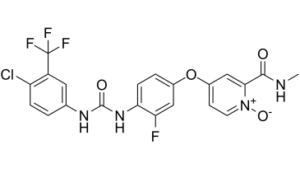Regorafénib N-oxyde (M2)
This product is for research use only, not for human use. We do not sell to patients.

For small sizes, please check our retail website as below: www.invivochem.com
| Size | Price | Stock |
|---|---|---|
| 100mg | $750 | Check With Us |
| 250mg | $1250 | Check With Us |
| 500mg | $1875 | Check With Us |
Cat #: V29157 CAS #: 835621-11-9 Purity ≥ 99%
Description: Regorafénib N-oxyde M2 is a major and active metabolite of Regorafenib.
Top Publications Citing Invivochem Products
Publications Citing InvivoChem Products
Product Promise

- Physicochemical and Storage Information
- Protocol
- Related Biological Data
- Stock Solution Preparation
- Quality Control Documentation
| Molecular Weight (MW) | 498.81 |
|---|---|
| Molecular Formula | C21H15ClF4N4O4 |
| CAS No. | 835621-11-9 |
| SMILES Code | FC1=CC(OC2=CC=[N+]([O-])C(C(NC)=O)=C2)=CC=C1NC(NC3=CC(C(F)(F)F)=C(Cl)C=C3)=O |
| Synonyms | Regorafénib N-oxyde; |
| Solvent volume to be added | Mass (the weight of a compound) | |||
|---|---|---|---|---|
| Mother liquor concentration | 1mg | 5mg | 10mg | 20mg |
| 1mM | 2.0048 mL | 10.0239 mL | 20.0477 mL | 40.0954 mL |
| 5mM | 0.4010 mL | 2.0048 mL | 4.0095 mL | 8.0191 mL |
| 10mM | 0.2005 mL | 1.0024 mL | 2.0048 mL | 4.0095 mL |
| 20mM | 0.1002 mL | 0.5012 mL | 1.0024 mL | 2.0048 mL |
The molarity calculator equation
Mass(g) = Concentration(mol/L) × Volume(L) × Molecular Weight(g/mol)
Mass
=
Concentration
×
Volume
×
Molecular Weight*
The dilution calculator equation
Concentration(start)
×
Volume(start)
=
Concentration(final)
×
Volume(final)
This equation is commonly abbreviated as: C1 V1 = C2 V2
Concentration(start)
C1
×
Volume(start)
V1
=
Concentration(final)
C2
×
Volume(final)
V2
Step One: Enter information below
Dosage mg/kg
Average weight of animals g
Dosing volume per animal µL
Number of animals
Step Two: Enter the in vivo formulation
%DMSO
+
%
+
%Tween 80
+
%ddH2O
Calculation Results:
Working concentration:
mg/ml;
Method for preparing DMSO master liquid:
mg
drug pre-dissolved in
µL
DMSO(Master liquid concentration
mg/mL)
,Please contact us first if the concentration exceeds the DMSO solubility of the batch of drug.
Method for preparing in vivo formulation:
Take
µL
DMSO master liquid, next add
µL
PEG300, mix and clarify, next add
µL
Tween 80,mix and clarify, next add
µL
ddH2O,mix and clarify.
Note:
- (1) Please be sure that the solution is clear before the addition of next solvent. Dissolution methods like vortex, ultrasound or warming and heat may be used to aid dissolving.
- (2) Be sure to add the solvent(s) in order.




































